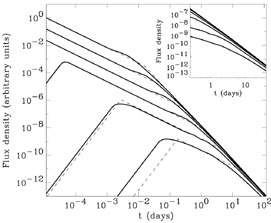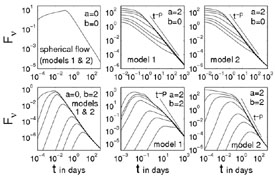


I. Generalizations: V. Angular Dependent Jets and the Structured Jet Model
In a realistic jet one can expect either a random or regular
angular dependent structure. Here there are two dominant effects.
As the ejecta slows down its Lorentz factor decreases and an
observer will detect radiation from an angular region of size
 -1 (see
Section IVC). At the same time
the mixing within the ejecta will lead to an intrinsic averaging
of the angular structure. Thus, both effects lead to an averaging
over the angular structure at later times.
-1 (see
Section IVC). At the same time
the mixing within the ejecta will lead to an intrinsic averaging
of the angular structure. Thus, both effects lead to an averaging
over the angular structure at later times.
Several authors
[219,
347,
446]
suggested independently a different interpretation to the
observed achromatic breaks in the afterglow light curves. This
interpretation is based on a jet with a regular angular structure.
According to this model all GRBs are produced by a jet with a
fixed angular structure and the break corresponds to the viewing
angle. Lipunov et al.
[219]
considered a "universal"
jet with a 3-step profile: a spherical one, a 20° one and a
3° one. Rossi et al.
[347]
and Zhang and Mészáros
[446]
considered a
special profile where the energy per solid angle,
 (
( ), and the Lorentz factor
), and the Lorentz factor
 (t = 0,
(t = 0,
 ) are:
) are:
 |
(106) |
and
 |
(107) |
where  j is a
maximal angle and core angle,
j is a
maximal angle and core angle,
 c, is
introduced to avoid a divergence at
c, is
introduced to avoid a divergence at
 = 0 and the parameters
a and b here define the energy and Lorentz factor angular
dependence. This core angle can be taken to be smaller than any
other angle of interest. The power law index of
= 0 and the parameters
a and b here define the energy and Lorentz factor angular
dependence. This core angle can be taken to be smaller than any
other angle of interest. The power law index of
 , b, is
not important for the dynamics of the fireball and the computation
of the light curve as long as
, b, is
not important for the dynamics of the fireball and the computation
of the light curve as long as
 (t = 0,
(t = 0,
 )
)

 0(
0( ) >
) >
 -1 and
-1 and
 0(
0( ) >> 1.
) >> 1.
To fit the constant energy result
[105,
291,
310] Rossi et al.
[347]
consider a specific angular structure with a = 2.
Rossi et al.
[347]
approximate the evolution assuming that at
every angle the matter behaves as if it is a part of a regular BM
profile (with the local
 and
and
 (t,
(t,
 )) until
)) until
 (t,
(t,
 ) =
) =
 -1. Then the
matter begins to
expand sideways. The resulting light curve is calculated by
averaging the detected light resulting from the different angles.
They find that an observer at an angle
-1. Then the
matter begins to
expand sideways. The resulting light curve is calculated by
averaging the detected light resulting from the different angles.
They find that an observer at an angle
 o will detect a
break in the light curve that appears around the time that
o will detect a
break in the light curve that appears around the time that
 (t,
(t,
 o) =
o) =
 o-1
(see Fig. 28). A
simple explanation of break is the following: As the evolution
proceeds and the Lorentz factor decreases an observer will detect
emission from a larger and larger angular regions. Initially the
additional higher energy at small angles,
o-1
(see Fig. 28). A
simple explanation of break is the following: As the evolution
proceeds and the Lorentz factor decreases an observer will detect
emission from a larger and larger angular regions. Initially the
additional higher energy at small angles,
 <
<
 o
compensates over the lower energies at larger angles
o
compensates over the lower energies at larger angles
 >
>
 o. Hence the
observer detects a roughly constant energy
per solid angle and the resulting light curve is comparable to the
regular pre-jet break light curve. This goes on until
o. Hence the
observer detects a roughly constant energy
per solid angle and the resulting light curve is comparable to the
regular pre-jet break light curve. This goes on until
 -1(0) =
-1(0) =
 o. After this
stage an further increase in the viewing angle
o. After this
stage an further increase in the viewing angle
 -1 will
result in a decrease of the energy per unit solid angle within the viewing
cone and will lead to a break in the light curve.
-1 will
result in a decrease of the energy per unit solid angle within the viewing
cone and will lead to a break in the light curve.
 |
Figure 28. The light curves
of an inhomogeneous jet observed from different angles (From
Rossi et al.
[347]).
From the top |
This interpretation of the breaks in the light curves in terms of
the viewing angles of a standard structured jets implies a
different understanding of total energy within GRB jets and of the
rate of GRBs. The total energy in this model is also a constant
but now it is larger as it is the integral of Eq. 106
over all viewing angles. The distribution of GRB luminosities,
which is interpreted in the uniform jet interpretation as a
distribution of jet opening angles is interpreted here as a
distribution of viewing angles. As such this distribution is fixed
by geometrical reasoning with
P( o)
d
o)
d o
o
 sin
sin o
d
o
d o (up
to the maximal observing angle
o (up
to the maximal observing angle
 j). This
leads to an implied isotropic energy distribution of
j). This
leads to an implied isotropic energy distribution of
 |
(108) |
Guetta et al. [153] and Nakar et al. [266] find that these two distributions are somewhat inconsistent with current observations. However the present data that suffers from numerous observational biases is insufficient to reach a definite conclusions.
In order to estimate better the role of the hydrodynamics on the
light curves of a structured jet
Granot and Kumar
[135],
Granot et al.
[136]
considered two simple models for the hydrodynamics. In the first (model
1) there is no mixing among matter moving at different angles i.e.
 (
( , t) =
, t) =
 (
( , t0). In
the second (model 2)
, t0). In
the second (model 2)
 is a function of
time and it is averaged
over the region to which a sound wave can propagate (this
simulates the maximal lateral energy transfer that is consistent
with causality). They consider various energy and Lorentz factors
profiles and calculate the resulting light curves (see
Fig. 29).
is a function of
time and it is averaged
over the region to which a sound wave can propagate (this
simulates the maximal lateral energy transfer that is consistent
with causality). They consider various energy and Lorentz factors
profiles and calculate the resulting light curves (see
Fig. 29).
 |
Figure 29. Light curves for
structured jets (initially
|
Granot and Kumar
[135]
find that the light curves of models 1
and 2 are rather similar in spite of the different physical
assumptions. This suggests that the widening of the viewing angle
has a more dominant effect than the physical averaging. For
models with a constant energy and a variable Lorentz factor
((a, b) = (0, 2)) the light curve initially rises and there
is no jet break, which is quite different from observations for most
afterglows. For
(a, b) = (2, 2), (2, 0) they find a jet break at
tj when
 (
( o) ~
o) ~
 o-1.
For (a, b) = (2, 2)
the value,
o-1.
For (a, b) = (2, 2)
the value,  1,
of the temporal decay slope at t < tj
increases with
1,
of the temporal decay slope at t < tj
increases with
 o, while
o, while
 2 =
2 =
 (t >
tj) decreases with
(t >
tj) decreases with
 o. This
effect is more prominent in model
1, and appears to a lesser extent in model 2. This suggests that
o. This
effect is more prominent in model
1, and appears to a lesser extent in model 2. This suggests that

 =
=
 1 -
1 -
 2 should
increase with tj,
which is not supported by observations. For
(a, b) = (2, 0), there
is a flattening of the light curve just before the jet break
(also noticed by Rossi et al.
[347]),
for
2 should
increase with tj,
which is not supported by observations. For
(a, b) = (2, 0), there
is a flattening of the light curve just before the jet break
(also noticed by Rossi et al.
[347]),
for  o >
3
o >
3 c.
Again, this effect is larger in model 1, compared to model 2 and
again this flattening is not seen in the observed data.
c.
Again, this effect is larger in model 1, compared to model 2 and
again this flattening is not seen in the observed data.
Clearly a full solution of an angular dependent jet requires full
numerical simulations. Kumar and Granot
[202]
present a simple
1-D model for the hydrodynamics that is obtained by assuming
axial symmetry and integrating over the radial profile of the
flow, thus considerably reducing the computation time. The light
curves that they find resemble those of models 1 and 2 above
indicating that these crude approximations are useful. Furthermore
they find relatively little change in
 (
( ) within
the first few days, suggesting that model 1 is an especially
useful approximation for the jet dynamics at early times, while
model 2 provides a better approximation at late times.
) within
the first few days, suggesting that model 1 is an especially
useful approximation for the jet dynamics at early times, while
model 2 provides a better approximation at late times.